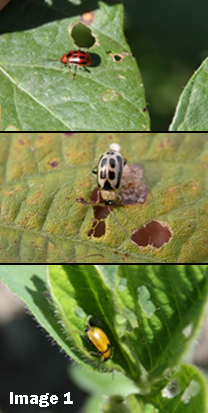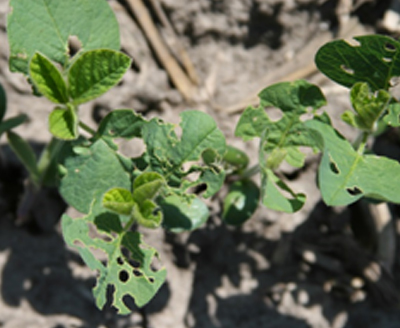
- Early season insect pests such as wireworms, seedcorn maggots and white grubs can damage seeds and seedlings of soybeans and corn.
- When peak emergence of overwintering bean leaf beetle adults coincides with soybean emergence/ early growth it may result in heavy feeding on soybean seedlings.
- If no sampling was done last fall for soybean cyst nematodes, consider sampling in the spring as long as the ground is not frozen or too wet.
Please refer to the previous article, “early season pests of corn” for sampling recommendations for wireworms, seed corn maggots and white grubs. These insect pests can also damage soybean seed and seedlings.
Bean Leaf Beetle (BLB):
BLB’s have two generations per year in IA, IL and IN (summer and early fall). However we talk about three adult populations per season as the first beetles seen in the spring are the overwintering adults. BLB adults are ¼” long with color variations from yellow, tan or red. Some will have two black spots on each wing cover but others will have no spots at all. The one distinguishing characteristic of BLB adults is a black triangular mark on their wing covers directly behind the thorax (Image 1). The larva is white with a brown head and a brown plate on the top of their last abdominal segment. Although the larvae feed on root nodules, their damage is of little importance. BLB adults are foliar and pod feeders, vectors of a virus and can cause stand and yield reductions if pressure is high and the timing is right. Peak emergence of the overwintering population will sometimes coincide with soybean emergence and early growth resulting in heavy feeding on cotyledons, stems, unifoliate and trifoliate leaves (Image 2). Early in the season, walk newly emerged soybean fields looking for the presence of beetles or feeding damage. If damage is noted, evaluate 10 plants in at least 5 areas of the field and determine the average percent defoliation. Also, record the number of beetles found in each of those areas to get an estimate of the number of beetles per plant. If 3-5 beetles are found per plant from VE-VC or 30% defoliation is noted from V1-V7, a treatment is recommended.
Diagnosing early season soybean damage can be somewhat challenging. Early BLB damage can be mistaken for seed corn maggot or slug damage. Seed corn maggots can leave tunnels along the cotyledons. If you dig the damaged seedlings, you may find some mining along the stem. BLB’s can also feed on cotyledons but they will start by gently scraping off the surface leaving circular spots of eaten tissue. Under heavy infestations these circular feeding signs/holes will coalesce and may resemble slug damage. If BLB’s are present you might see the adults moving while scouting the field. Slugs will be more “aggressive” in their feeding potentially skeletonizing the leaves while leaving slime trails on the leaf surface. Neonicotinoid seed treatments can protect soybeans from seed corn maggot and BLB damage but slugs will be unaffected by these seed treatments.

Soybean Cyst Nematode (SCN):
SCN is not only an early season problem but one that once is present, it is always present. SCN symptoms are not always visible and infections can go undetected for several years. The purpose of sampling for SCN is to determine SCN levels in a field and diagnose the potential for damage to make management decisions accordingly. Sampling can be done at any time as long as the ground is not frozen or too wet. If SCN samples were not collected last fall, consider sampling in the spring.
Samples can be collected in a “W” or a “Z” pattern across the field. In fields where SCN has not been diagnosed, soil cores can be collected from “high risk” areas. These high risk areas are the “most likely” spots in the field where SCN may be first found such as areas with high pH, low yielding areas, low spots, along fence lines etc. Collect multiple soil cores (20-30 cores, 8-10” deep) for every 20 acres. Put the samples in a plastic bag (about one pint of soil per bag) and mail the samples to a reliable lab for analysis. Label the bag properly and keep it cool until it’s shipped but try to ship it as soon as possible. The lab report will indicate the number of eggs found/ 100 cc of soil which will help determine the severity of the problem.
Additionally, if SCN resistant varieties have failed to perform in SCN infested fields (their yields continue to decline over time, there is a large number of cysts found on roots), you may want to consider doing an HG type test. This is a greenhouse test that is done to determine how well the SCN population in a given field reproduces on various sources of resistance. A two gallon composite sample collected from about 20-40 spots throughout the field are needed for the HG type test. Land grant University clinics in your area will most likely perform this test or will provide more information about HG type test. If you are hoping to make seed selection decisions based on the results from your HG type test, make sure to give yourself plenty of time. The results from this test can take five weeks or more, so fall sampling or early spring sampling is advised.
Image 1: Color variation of bean leaf beetles. (Note the black triangular spot behind thorax) (Source: GROWMARK, Inc.)
Image 2: Early bean leaf beetle damage on soybean seedlings. (Source: GROWMARK, Inc.)